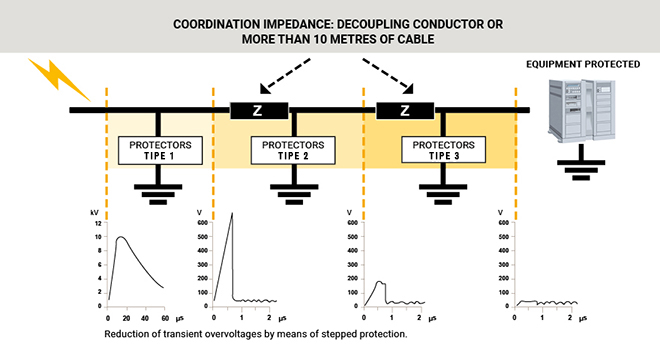The protection against overvoltages in an electrical installation is vital to guarantee peoples safety and avoid short and long term damages to equipment. A large majority of the installations are protected against overloads and derivations, but the installed devices do not protect against transient overvoltages (due to lightning) and permanent overvoltages (for example due to neutral failures).
However, although the importance of the use of surge protectors in homes, commercial spaces and industries is known, it is not adequately carried out in all cases.
In the following, we will resolve some questions in order to explain how to design a correct surge protection so as to avoid the damages that the overvoltages can cause.
What is cascaded or stagged overvoltages protection?
In line with the staggered protection principles and energetic coordination, the selective disposition of surge protection devices according to the risk that is to be avoided, are known as staggered, coordinated or cascaded surge protection.
Depending on the overvoltage risk to protect, we differentiate three types of surge protectors distributed in cascade in the installation: surge devices type 1, 2 and 3.
A type 1 surge protector offers a strong protection, it guarantees that if a lightning strike hits the power network this acts by draining the excess of current. However, although it is a type of protector that supports high currents, it is a slow device that leaves a high residual voltage for the connected equipment.
The type 2 protector is a medium surge protection that is installed after the type 1 protector in order to dissipate the residual voltage that has remained. A type 2 protector could not withstand a direct discharge, but is used for to attenuated discharges or line inductions. In some cases, the type 2 protector can also leave a residual voltage, so it would be necessary to complement the protection with a type 3 protector.
The type 3 surge protectors are those that offer a fine protection, in other words, they cannot withstand big large surges. However, they are the fastest, so the residual voltage they leave is very low.
In all cases, before establishing what type of surge protectors are used and where they are installed, it is essential to make a previous study of the electric installation and its line diagram.
What follows are several examples of cascaded surge protection.
Stepped surge protection in the residential area
In residential surge protection for example, in an apartment building, the usual protection could be to use a T1+T2 (for example, a AT-8089) on the main board, located in the entrance of the building. In this way, the power supply input from the electrical company is protected. A type 2+3 protector would then be placed in the secondary board located in each residence or, as an alternative, a permanent and transient surge protector that combines the two types of surge protection could be used.
On another hand, telephone supply as well as antennas and data connections must also be protected. The protection of these type of cables is highly recommended because they connect very sensitive devices to overvoltages.
For example, in apartment blocks, where external lightning protection is not always necessary, the antenna of the building located on the roof becomes a preferred path for lightning, thus creating a way for surges to enter through the wiring.

Protection against surges in the commercial or tertiary field
The protection against surges in the commercial field is similar to the protection in the domestic sphere, but adapted to the needs of each business and the installation characteristics.
Businesses usually have several electric panels. In this case, it could be a shopping centre, following the logic of the staggered protection, we could put a type 1+2 protector in the transformers, a type 2 protector in each shop panel and in the secondary panel a type 3 protector.
Protection against overvoltages in the industrial field
On an industrial level, it is necessary to make a detailed study of the line diagram for the installation to correctly design the surge protection. In each industry, the electric installation could have different characteristics and has to be adapted to particular needs. If we rely on the theory, we will install a type 1 protection in the main panels, type 2 in the secondaries and type 3 in the tertiary, but this could vary in each individual case.
We must not forget the lines that exit to the outside of the building, because they are susceptible to receive overvoltages. It would be necessary to put type 1 and 2 protectors on those lines as lightning could easily enter through them.
The protection must always be staggered from the point where the overvoltage can enter. Overvoltages can enter from the power supply or through any cable that exits the building. It is there where we have to put the strongest protection. From this point, moving further into the building, the protection is staggered until it reaches a type 3 protection.
If you need advice on surge protection please contact us.
